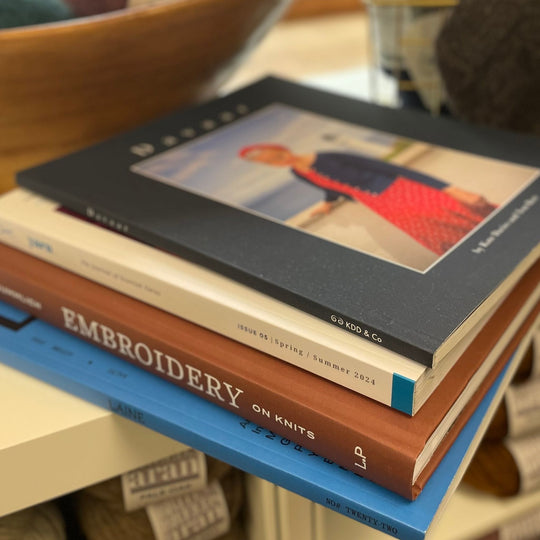Ever knit a sweater only to find that it doesn’t fit the way you want? Or are you afraid to knit a sweater only to find, after hours of work, that it doesn’t fit? Sweater fit is something that you learn a bit as you go, as you learn what sweater preferences you have in fit, ease, shape, and length. But I’m hoping you can learn a bit from what I’ve learned knitting sweaters for myself and for others, to save you learning the hard way!
Basics
Two pieces of information in any sweater pattern will help decode how it will fit: the construction and the recommended ease. Sweaters can be constructed in several ways, the most common appearing to be (A) round yoke, (B) raglan, and (C) set-in sleeve.

A) Altheda sweater by Jennifer Steingass, a round yoke pullover knit in Plotulopi

B) Vanilla Sweater by Corinne Tomlinson, a raglan pullover in Finullgarn

C) Audrey in Unst by Gudrun Johnston, a set-in sleeve cardigan
Round yoke sweaters are the classic Icelandic sweaters with a round pattern around the shoulders and increases happening evenly around the round in usually 3 to 5 increase rows. Raglan sweaters have diagonal increases from the collar to the underarms - like a classic baseball T or lots of sweatshirts. Set-in sleeves are usually knit flat (at least the top) and then sleeves are knit separately and sewn in afterwards, creating vertical seams from the top of the shoulder to the underarm.
OK, but what does this have to do with fit? The different sweater types generally need different amounts of ease! Ease is the difference between your actual bust measurement and the garment’s bust measurement. In a pattern, a designer will usually give a recommended amount of ease, which tells you how much larger than your actual bust the designer had in mind when they designed the pattern. Because of the constraints of the type of construction, different types of sweaters often look better with different amounts of ease. Round yoke sweaters usually need more ease, then raglans in the middle, and set-in sleeves with the least. If you come across a pattern that does not say what ease is recommended, I’d think about doing a little more for round yoke, a bit less for raglan, and the least for set-in sleeve patterns.

How about some examples? OK! Here are the finished garment measurements for the Vanilla Sweater: 34 1⁄4 (38, 42, 46 1⁄2, 50 1⁄2)(54 1⁄4, 58 1⁄4, 62, 66) in. The recommended ease is 3 ½ to 6 inches of positive ease and the sweater is a raglan type construction. If, for example, a person had an actual bust size of 46 inches, what size should they knit? Adding the lower recommended ease of 3 ½ inches to 46, you get 49 ½ inches and adding the higher ease, you get 52 inches. The only size that falls between those numbers is 50 ½ inches, so the recommended size is Size E.
Personal Preference!
Now, you can actually take all of that and throw it out the window if you want! The best way to actually figure out how much ease YOU like is to measure a sweater that you like to wear. It can be handknit or commercially made, but it’s the most helpful to match the construction style - which you can tell by the seams or lines around the shoulders. Round yokes have no visible lines of increases or seams around the shoulders, raglans have diagonal lines of increases, and set-in sleeves have vertical seams. You may decide that you like a close-fitting sweater with 2 inches of ease or even zero ease! You may also decide that you like an even looser sweater and want 8 inches of ease or more.
If you figure out you like certain amounts of ease, you have two options. You can either pick patterns with that recommended amount of ease or you can knit whatever pattern you like with that amount of ease.
Last Considerations
I know this is a lot of information, but there is a little bit more that can help avert disaster. Different knitting techniques make sweaters more or less stretchy. The most important to note is that colorwork (including Fair Isle and Scandinavian style colorwork) are less stretchy than knitting with one color (stockinette, garter, or even most textures or cables). For that reason, it’s a bit riskier to knit a full colorwork sweater, at least with colorwork across the bust, with less than 2 or so inches of ease. That said - it’s not as much of a concern with colorwork across the yoke or around the hem and cuffs, so there are still options for close-fitting sweaters with colorwork.






























14 Comments -
Rosemary • -
Kirsten • -
Maggie • -
Nancy •
← 1 2 3
Thank you, that is really clear and easy to understand.
I would like to make the Altheda sweater but I think I want to use a different yarn….not the plutopi. Is changing the yarn type a viable option? Thanks. K.
Thank you for the information on getting a sweater to fit. I am going to try to knit a Gansey sweater and can use lots of your tips.
And where do you take the “bust” measurement? I have heard the high bust (basically right under the armpits) is the ideal measurement as opposed to the fullest part of the bust (ie. where a woman would be measured for a bra). Then add the ease measurement to the high bust number. The reasoning for the high bust, and I believe this is correct, is because it is a truer “skeleton” measurement.
What are your thoughts?
Thanks for discussing this. So much time, money, blood, sweat and tears are incorporated into any project. And then have it not fit. AARGH!!! as Charlie Brown used to say in moments of anguish.
n